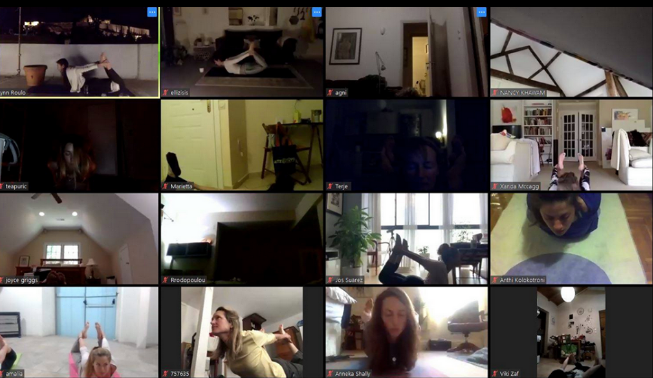When the lockdowns went into effect in March, for most of the world, it stopped being an option to go to your favorite yoga studio for a class. This stunned studios and students alike, but many yoga teachers reacted quickly and started offering classes online. For many of us teaching yoga, we think of yoga as medicine. There wasn’t a moment when we thought we’d wait until quarantine ended to offer our services. Quite the opposite–for many of us, we felt it was more critical than ever to get our tools of yoga and meditation to our communities because we knew people would need them during this difficult time. So we went online, teaching via Zoom and live-streaming on Facebook and Instagram.
I started teaching yoga online via Zoom back in November so I had some experience with the platform. However, my pre-pandemic classes had a mix of live students in the studio and remote students. It was like a Peloton model (the popular at-home exercise bike featuring live-streamed spin classes), and it worked really well. I felt super energized after teaching a class.
Pandemic yoga classes are very different because all your students are remote. You lose eye contact, a clear line of vision to the participants and lots of other non-verbal clues from the audience. Maybe even more important, the energy exchange feels completely different. All these things add up to a huge difference, and these 100% remote classes drain me in a way I have never experienced in my 10 years of teaching yoga.
I’ve thought a lot about why that is and have four easy things you can do to help keep your online yoga teacher going strong throughout this period.
- Turn on your video
I understand your desire to keep your video off. I too like taking classes without worrying about what I look like or how messy my room is. But I cannot tell you how hard it is to give a set of instructions to a row of static screens with zero feedback. Trust me, I don’t care what you or your house look like. I am so grateful to the students who leave their video on because it gives me small visual clues about if they can hear me, if they can copy the posture I just explained and so forth. If you can keep your video on so your yoga teacher has at least a tiny feedback loop, it helps us a lot. It feels eerie teaching to a sea of motionless screens.
- Mute your microphone
Most teachers know how to “mute all participants” for a class to avoid that one student breathing deeply into their audio disturbing everyone else. There are sound distractions that can come up: kids, dogs, garbage trucks, you get the idea. A lot of us are new to teaching yoga online and for those teachers who don’t know to mute everyone, or those who may forget because they are focused on delivering the class, it helps everything run smoothly if you mute yourself. That single “mute” keystroke is so simple and so powerful.
- Donate
Your yoga teacher is likely offering classes because he or she wants you to feel better, especially given the difficult situation we all find ourselves in with the pandemic. A drive to benefit others is the motivation for most yoga teachers to offer their classes, and many are offering their classes on a donation basis to make it accessible for as many as possible. We think of yoga and meditation as medicine, and we want you to heal. That said, most yoga teachers were earning money in a studio setting. The gesture of even a tiny donation goes a long way for us. It reminds us that you value our contribution, and we appreciate it a lot.
- Follow up – we love to hear from you!
Yes, we are trained in the healing arts, have lots of meditation experience, are trained to stay present and neutral and are good at understanding the bigger picture. All of this is true. We are also human. We get tired. We have bad days. And we miss seeing you in person. Video is fine, but it means that we don’t get to chat with you the same way after class. We don’t get the same energy exchange we used to. It means a lot to me when a student sends a quick follow up message saying hello, they feel better or the class was helpful. I bet your yoga teacher would love to hear from you too!
That’s it–those four tips will help keep your yoga teacher going strong during this pandemic. The interesting thing is that this self-isolation means we are connecting in new ways. I have people from the U.S., the U.K. and all over Europe dialing into my Zoom yoga classes in ways they didn’t before, even though I’ve been offering online yoga since November. It’s a moment to build a new world with each other. If the virus can spread exponentially, what if we can have exponential growth in kindness and awareness the same way? I’m hopeful for the future, and I’m grateful for all the other yoga teachers out there offering their services.
Sat nam.
Lynn Roulo is an American Kundalini Yoga instructor living in Athens, Greece. She writes about her journey going from a San Francisco CFO to an Athens yoga instructor. You can join her classes via Zoom by following her schedule or you can find her videos on YouTube.











Read 0 comments and reply